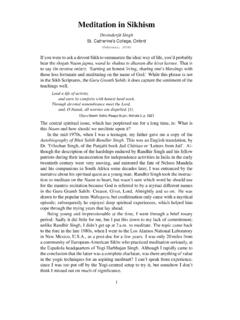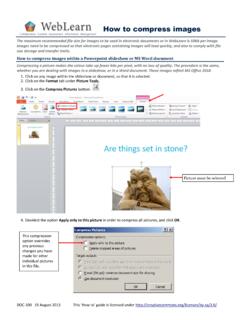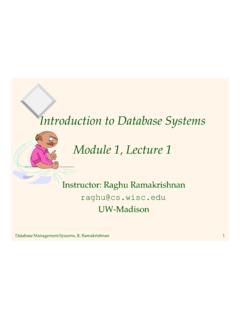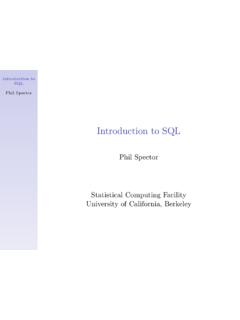Transcription of Databases: MySQL Introduction
1 Databases: MySQL Introduction Databases: MySQL Introduction IT Learning Programme 2 How to Use this User Guide This handbook accompanies the taught sessions for the course. Each section contains a brief overview of a topic for your reference and then one or more exercises. Exercises are arranged as follows: A title and brief overview of the tasks to be carried out; A numbered set of tasks, together with a brief description of each; A numbered set of detailed steps that will achieve each task. Some exercises, particularly those within the same section, assume that you have completed earlier exercises. Your teacher will direct you to the location of files that are needed for the exercises. If you have any problems with the text or the exercises, please ask the teacher or one of the demonstrators for help. This book includes plenty of exercise activities more than can usually be completed during the hands-on sessions of the course.
2 You should select some to try during the course, while the teacher and demonstrator(s) are around to guide you. Later, you may attend follow-up sessions at IT Learning Programme (ITLP) called Computer8, where you can continue work on the exercises, with some support from IT teachers. Other exercises are for you to try on your own, as a reminder or an extension of the work done during the course. Text Conventions A number of conventions are used to help you to be clear about what you need to do in each step of a task. In general, the word press indicates you need to press a key on the keyboard. Click, choose or select refer to using the mouse and clicking on items on the screen. If you have more than one mouse button, click usually refers to the left button unless stated otherwise. Names of keys on the keyboard, for example the Enter (or Return) key are shown like this ENTER. Multiple key names linked by a + (for example, CTRL+Z) indicate that the first key should be held down while the remaining keys are pressed; all keys can then be released together.
3 Words and commands typed in by the user are shown like this. Labels and titles on the screen are shown l i k e t h i s. Drop-down menu options are indicated by the name of the options separated by a vertical bar, for example F i l e | P r i n t. In this example you need to select the option P r i n t from the F i l e menu or tab. To do this, click when the mouse pointer is on the F i l e menu or tab name; move the pointer to P r i n t; when P r i n t is highlighted, click the mouse button again. A button to be clicked will look l i k e t h i s. The names of software packages are identified like this, and the names of files to be used l i k e t h i s. Databases: MySQL Introduction 3 IT Learning Programme Software Used XAMPP Files Used Revision Information Version Date Author Changes made Sep 2013 Mohammad Yaqub Creation of the text Mar 2014 Mohammad Yaqub Update some text and examples May 2014 Mohammad Yaqub Further revision to text and exercises Sep 2014 Mohammad Yaqub Major revision for the whole book Mar 2015 Mohammad Yaqub Minor revision for some exercises Jun 2015 Mohammad Yaqub Minor revision to the slides Nov 2015 Mohammad Yaqub Minor revision to the slides Copyright This document is made available under a Creative Commons Attribution-NonCommercial-ShareAlike CC BY-NC-SA licence by Mohammad Yaqub who asserts his right to be identified as the author.
4 Note that some images used in the document and presentations are copyright of their owners and may be subject to different copyright conditions. Where possible this has been noted in the text. If an error in attribution/copyright has been made, please contact the author who will be pleased to make the necessary corrections. Screenshots are copyright of the respective software suppliers. Acknowledgement Most of the syntax in this book was adopted from Databases: MySQL Introduction IT Learning Programme 4 Contents 1 Introduction .. 7 What is a database ? .. 7 What is SQL? .. 8 MySQL .. 8 2 Installation Guide to use MySQL .. 9 XAMPP .. 9 phpMyAdmin .. 9 How to Complete the Exercises .. 10 3 Setting up MySQL .. 12 Creating/Editing/Dropping SQL users .. 12 Creating/Dropping Databases .. 13 4 Creating Tables .. 15 Data Types .. 15 Primary Key ..16 Linking Tables via Primary Foreign Keys .. 21 5 Manipulating Data in Tables .. 22 INSERT Statement.
5 22 UPDATE Statement .. 23 DELETE Statement .. 24 6 Queries .. 26 SELECT Statement .. 26 Where Clause .. 27 Comparisons and Conditions .. 28 7 Advanced Queries .. 31 Sorting Data ORDER BY Clause .. 31 Querying Multiple Tables .. 31 Pseudonyms for Table or Column Names .. 32 Subquery (inner SELECT) .. 33 The IN Operator .. 33 Basic String Comparison Functions .. 34 The BETWEEN Operator .. 35 8 Importing and Exporting .. 37 Migration from/to MySQL database only .. 37 Databases: MySQL Introduction 5 IT Learning Programme 9 What is Next? .. 38 Explore phpMyAdmin .. 38 Read a book or tutorials about MySQL or SQL in general .. 38 Databases: MySQL Introduction IT Learning Programme 6 Exercises Exercise 1 Create MySQL users .. 13 Exercise 2 Create MySQL database .. 14 Exercise 3 Create MySQL table .. 17 Exercise 4 Create the other 3 MySQL tables using the import facility. 19 Exercise 5 Create Foreign Key constraints .. 21 Exercise 6 Insert data to tables.
6 23 Exercise 7 Update data in a table .. 24 Exercise 8 Delete data from a table .. 25 Exercise 9 Querying data from a table .. 27 Exercise 10 Querying specific records .. 28 Exercise 11 Querying data using conditions .. 30 Exercise 12 Retrieving sorted records .. 31 Exercise 13 Querying multiple tables .. 32 Exercise 14 Querying multiple tables: use primary-foreign keys relationship 33 Exercise 15 Querying multiple tables: use primary-foreign keys relationship 33 Exercise 16 Querying multiple tables: use IN operator .. 34 Exercise 17 The use of LIKE and NOT LIKE .. 35 Exercise 18 The use of STRCMP() .. 35 Exercise 19 Querying data BETWEEN 36 Databases: MySQL Introduction 7 IT Learning Programme 1 Introduction The Structured Query Language (SQL) is the language of databases. SQL was, is, and will stay for the foreseeable future the database language for relational database servers such as IBM DB2, Microsoft SQL Server, MySQL , Oracle, Progress, Sybase Adaptive Server, and dozens of others.
7 SQL supports a small but very powerful set of statements for manipulating, managing, and protecting data stored in a database . This power has resulted in its tremendous popularity. Almost every database server supports SQL or a dialect of the language. Currently, SQL products are available for every kind of computer, from a small handheld computer to a large server, and for every operating system, including Microsoft Windows, Mac and many UNIX variations. What is a database ? A database is a structured collection of data that is used by the application systems of some given enterprise, and that is managed by a database management system. For the purpose of this course, think of a database as a collection of tables which are connected to each other. IT Learning Programme (ITLP) in the University of Oxford offers a course on how to design a database . This course is a pre-requisite to this course. However, if you did not attend the database designing course, please read the following paragraphs.
8 As we mentioned, a database is a collection of tables. Each table is similar to a spreadsheet table in which each row is called a record and each column is called a field. For example, if we need to create a table that contains students information, we might have the following fields Data can be entered to this table so you can get the following table Although this table contains students information, it does not contain each student s grades. This is fine because the grades have to appear in a different table to reduce data redundancy. This is called database normalisation. The grades table might look like Grade_ID St_ID Course_ID Grade_Value Comments St_ID St_Name St_DateOfBirth St_Email St_ID St_Name St_DateOfBirth St_Email 45215 John Smith 21/5/1995 45287 Alison Green 5/11/1994 48652 Thomas Li 18/7/1998 51420 Susan Bailey 14/1/1991 52201 Will King 3/3/1997 Databases: MySQL Introduction IT Learning Programme 8 Notice how the Grades table is linked to the Students table via St_ID which appears in both tables.
9 The field St_ID in the Students table is acting as the primary key which is a unique id to identify each record in the table. The field St_ID in the Grades table is called the foreign key and it links to a primary key in a different table. You might have noticed that there is a field called Course_ID in the Grades table which is another foreign key to identify a grade s course. This means that there must be another table that contains data for different courses. Form the previous simple example you should now have an idea of what we mean by a database . It is important to understand the following concepts: database , table, record, field, primary key, foreign key and data normalisation. Next sections will build on this and focus on SQL and how to use it to build a complete database using MySQL . What is SQL? Structured Query Language (SQL) is a relational database language which allows you to create, delete, access and manipulate databases.
10 The following is a list of the main operations that can be formulated with SQL: creating new databases deleting a database creating new tables in a database deleting tables from a database creating and removing users ( database access control) executing queries against a database o retrieving data from a database o inserting records in a database o updating records in a database o deleting records from a database creating stored procedures in a database setting permissions on tables and procedures creating relationships between tables MySQL MySQL is a relational database Management System ( RDBMS ). It is used by most modern websites and web-based services as a convenient and fast-access storage and retrieval solution for large volumes of data. A simple example of items which might be stored in a MySQL database would be a site-registered user s name with associated password (encrypted for security), the user registration date, and number of times visited, etc.









